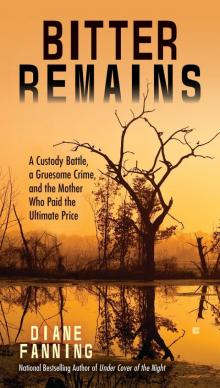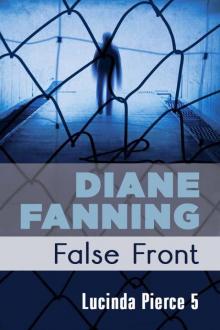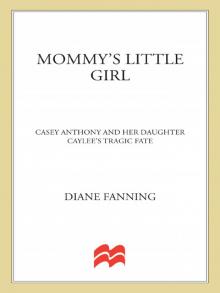- Home
- Diane Fanning
Bitter Remains Page 4
Bitter Remains Read online
Page 4
—
BY January 2010, Grant was ready to leave St. John. Jose was there for him to the very end. Jose said that he packed Grant’s bags while Grant snorted endless lines of cocaine. Then he drove Grant to Cruz Bay to catch the ferry to St. Thomas and the airport. It wasn’t until that last night that Jose learned that Grant’s legal name was Grant Hayes. Before then, he’d thought Grant Haze, Grant’s stage name, was his name at birth.
Grant wasn’t leaving USVI for his family in North Carolina, however—he was heading to New York City. Laura thought he was going there for a record deal. She had no idea that he was actually following Amanda Smith.
CHAPTER FIVE
AMANDA Perry Tucker was born seven years before Grant Hayes, on April 8, 1972. Her mother, Retha Faye, who was born in Taft, “The Friendliest Cotton Pickin’ Town in Texas,” had earlier had two daughters, Karen and Dorrie, with her first husband, and a son with her second husband, J. C. Tucker. After that, according to Amanda’s daughter, Sha Elmer, her maternal grandmother worked at the Black and White Club in Farmington, a purported whorehouse, and for that reason had no idea who fathered her next child, Amanda.
Amanda’s older half sister, Karen Berry, was already married and played a major role in raising the little girl, treating her just like one of her own children. Karen’s son, Dalton, was only two years younger than his aunt, and the two became close growing up, often under the same roof.
Somewhere in Retha Faye’s maze of husbands—family legend said that she’d wed eight or nine times—she married a power plant employee. According to Sha, he was a “horrible, mean man” who created a miserable home environment for his young stepdaughter and constantly moved the family from one small town to another in New Mexico and Texas. Amanda coped with the unpleasantness and disruptions by retreating into a rich daydream life. She yearned to escape the confines of her insular, provincial life and make her mark on the world.
Amanda was fifteen when Retha Faye broke up with that husband, and the teenager returned to New Mexico with her mother. But Amanda was eager to leave her family home, and she took the first escape hatch available when she met Scott Elmer. She hadn’t yet turned sixteen and Scott was twenty-one when they married in 1987. Their daughter Sha was born on June 7, 1989.
The marriage between Amanda and Scott was one constant squabble that ended in divorce when Sha was one year old. Amanda’s desire to move to Texas permanently ignited a battle over their daughter, which Amanda eventually won. She starting dating, then married, attorney Ron Adamson. While they were together, Amanda finished high school and took a few classes at the junior college, but called it quits on the marriage after eight months. The relationship was over two years after it began.
Amanda and then-five-year-old Sha moved in with Amanda’s sister, Karen Berry, in Lubbock, Texas. After a few months, Amanda found a place for just her and Sha, and she met a local children’s-theater director. Through him, she became acquainted with the terminology of that world as she helped with touring productions of Sleeping Beauty and Cinderella. At the same time, Amanda was going to school in Levelland. The long drives for those two activities caused her to put fifty thousand miles on her car in one year.
It was too much. School was the first thing to go. Amanda stuck with theater until a friend introduced her to a wealthy entrepreneur named Nicky Smith. Born in 1958 to a multigenerational family of cotton farmers, Nicky was fourteen years older than Amanda. He was the owner-operator of Valley Ag-Electric, a wholesale manufacturer of irrigation systems and equipment located in Olton, Texas, just north of his birthplace in Lubbock. At one point, he had five separate dealerships for that enterprise. He also leased the farmland to tenant farmers; owned a company that embroidered jackets, T-shirts and hats; and made road signs for the state. He spent a lot of time traveling to other countries like Brazil and Egypt, teaching people there how to grow cotton. After dating for a year, the two married on March 19, 1998.
This life was a dramatic change from what Amanda and Sha had previously known. There were no more worries about finding the money for groceries and rent. Sha was in fourth grade when they moved into the home Nicky purchased near Austin on Inks Lake, situated in the scenic Texas Hill Country. The lake, a reservoir created by a dam on the Colorado River, offered a wealth of outdoor recreation, including swimming, camping, picnicking and fishing; plus, Inks Lake State Park was adjacent to the lake and added backpacking, golf and cliff jumping to the list of possible activities.
Nicky traveled five hours north most weeks to run Valley Ag-Electric and returned home for the weekends. Sha attended school in nearby Burnet. With freedom from economic worries, Amanda had time to pursue personal interests, and she discovered a passion for painting, particularly acrylic abstracts. With Nicky, everything felt so safe and secure.
But their all-too-fleeting happiness ended in one awful moment.
It was the beautiful lake setting, unfortunately, that caused the end of this idyllic period. Not realizing that Inks Lake had been partially drained to accommodate work on the dam, Nicky jumped in on Memorial Day in 2000—and landed in just six inches of water. He broke his neck and was paralyzed from the shoulders down in the mishap.
He had a week-long stay in an Austin hospital before he was transferred to Lubbock, where a surgeon was doing experimental treatment for spinal injuries. Pneumonia landed him in the Intensive Care Unit there, and following his recovery from that setback, he was moved down to a rehab facility in San Antonio and put on a ventilator. Amanda was dissatisfied with his care in San Antonio, and Nicky was flown up to a different rehab in Dallas.
There Nicky learned that his diaphragm was permanently paralyzed and his life now depended on the ventilator. To make matters even worse, his spinal cord was dying and would progress into his brain stem, leaving him incapable of doing anything but blinking his eyes. Nicky decided he wanted the ventilator removed, and he wanted to go home for his last days of life. He died of his injuries on October 11, 2000.
The settlement of the estate was contentious, but since Amanda didn’t want any part of the business, issues were resolved when she sold her share to Nicky’s brother and made a few trades with Nicky’s adult children. She traded half of Nicky’s retirement account for ownership of the children’s half of the farmland.
Amanda was single again with a small daughter, but this time, she had a sizeable inheritance to cushion the blow. She had enjoyed participating in community theater and children’s theater for years, and now she decided to try to build a professional career in acting. Amanda auditioned and was accepted to a two-year program geared toward film and television at a conservatory in New York City.
She settled her mother Retha Faye into the house where she and Nicky had lived, to help out her mom and to prevent the house from sitting vacant. She brought Sha with her, and enrolled the girl in a Catholic school in the city. But after about a year, Sha, who had gotten behind in her studies, begged her mother to let her go stay with Aunt Karen in Texas, and Amanda agreed. Sha also lived part of the time with her father, Scott Elmer, in Farmville, New Mexico, where she started high school.
Back in Austin, Retha Faye fell and broke her leg, which set off a multitude of further health complications, so Amanda moved her other sister, Dorrie, into the house to care for their mother while she finished her studies in New York.
After getting her film and television degree, Amanda knew she had to go to Los Angeles—that’s where the work that she wanted to do was centered. She sold the Ink Lakes home and everything in New York and moved her mother into a little house in LA.
She scored some small parts out there. Among her credits were television shows like The O.C., The Sopranos, Dexter, Twins, Zoey 101, According to Jim and Century City, along with the Nicole Kidman movie, The Stepford Wives. Every role, however, was very minor and usually did not make the list of credits. Soon, Amanda realized she was going nowhere. Although she w
as only in her early thirties, her age was already a barrier for a woman trying to break into the business.
So Amanda went back to Texas with her mom and got her real estate license. Neither woman was happy, though, and soon Retha Faye moved in with Karen, and Amanda returned to New York.
In New York, Amanda finished a cosmetology education she’d begun in Texas and began managing a salon day spa on the upper east side of Manhattan but felt she was wasting her life in that position. In January 2007, she vacationed in the United States Virgin Islands and fell in love with St. John. After her fourteen-day getaway turned into a six-week stay, Amanda decided to relocate there. She returned to New York, sold her car, sublet her apartment, put some items in storage and sent a small shipment down to the island.
When she arrived, Amanda worked as a bartender before becoming a gallery director for the Artists’ Association of St. John, an organization formed in the 1990s with help from the Artists Association of Nantucket. When Amanda stepped into her position, there were 152 members, most of whom were full-time residents on the island. Each was given sixteen square feet to display their work. The featured artists each month got a whole wall dedicated to their art. The first exhibit of the gallery under Amanda’s watch was in August 2007. Amanda also had plans for daily art classes in subjects from oil painting and watercolor to pottery, sculpture, photography and jewelry making.
She told the St. John Tradewinds newspaper that she wanted to expand the membership to hobbyists. “I’d really like to get more people to come out and join the association. You don’t have to be a professional artist to join. There are a lot of people out there with talent who don’t see it for themselves.” She added a word to the aspiring artists: “Don’t judge yourself. It’s important to keep your channel open and just have fun. Every person is unique and there is no comparing one to the other because everything is so different.”
Amanda also noticed that there was no place on the island to buy what she needed to continue her own painting, so she decided to redesign an unused portion of the gallery space as Pirate’s Paradise Art Supply. Originally configured as two rooms and a hallway, a boyfriend and his cousin helped Amanda transform it into one large room with slat walls painted bright white. She stocked the space with a large selection of quality brushes, acrylics, watercolors, oils, canvas rolls and prestretched canvasses and paper. She also placed special orders for any unusual items the artists needed. The shop opened in November 2007. Among the featured works for the gallery in December that year were paintings by Amanda Smith.
In early 2008, Amanda took a trip to New Mexico to visit her teenage daughter, Sha, who was then living with her dad, and ended up bringing Sha back with her to St. John. There, Sha finished her junior year and started her senior year of high school before dropping out. Amanda was not happy with Sha’s decision to terminate her education and the conflict escalated into a physical altercation. After that, Sha returned to her father in New Mexico and got her GED, and she later rejoined her mother in USVI.
Upon Sha’s return to St. John, Amanda taught her daughter the business side of running the art-supply store and Sha became the manager of Pirate’s Paradise. Sha reveled in the energy of the island—unable to describe it but definitely feeling it every day.
—
AMANDA was out on a date when she first saw Grant Haze performing at the Parrot Club. She didn’t see him again for another six months. In the midst of all the beauty and tranquility, another relationship ended for Amanda and she grew lonely and depressed. Then, one night, she saw Grant Haze again. They talked and he gave her one of his CDs. Amanda felt their connection was instant and electric. As a ploy to get to know him better, Amanda asked him to teach her how to play the guitar and Grant agreed. She told Sha about the lessons and described her teacher as a performer who sounded like Darius Rucker, the lead singer and rhythm guitarist for the Grammy Award–winning group Hootie & the Blowfish.
She invited Grant to accompany her to a group dinner with a bunch of friends where it was her turn to cook that week. He soon started hanging out with her friends. The first time he kissed her, Amanda kicked him out of her home and avoided him for a week. She felt he was moving too fast and her own feelings for him were getting out of control. The ice thawed quickly, and soon Amanda could not see enough of him.
Those close to Grant saw Amanda as a “starry-eyed groupie,” said Mark Gierth. Many were appalled that he was cheating on Laura, who was still on the island with their two infant sons, but who thought he was using Amanda for her money and contacts.
From the start, even before they started dating, Amanda displayed signs of extreme jealousy. Any time another woman approached Grant, Amanda’s body language grew hostile and she sent venomous glares in her direction—a business problem for someone building a fan base.
It was no surprise that Jose took an instant dislike to Amanda. He snapped at her once and Grant came down on him hard, threatening to kill Jose if he ever spoke to Amanda again.
Sha met Grant Hayes when he came into Pirate’s Paradise looking for a sketch pad for a project he was doing for a local school. Sha knew Grant was teaching her mother to play the guitar. She had no idea, however, that the two of them were in a romantic relationship when she and her mother went to New York in October 2009 for a two-week visit. At the time, one of Amanda’s former boyfriends on the island was acting a bit crazy over their breakup—stalking and harassing Amanda. In a small place like St. John, there didn’t seem to be any way to avoid him, and his actions were causing increasing discomfort. Add to that Sha’s desire to move back to the city and renew her education, and the vacation turned into a relocation-planning trip.
They returned to USVI to prepare for the two of them to move back to New York. Sha finally learned the truth about what was going on between her mother and Grant on Thanksgiving Day 2009.
On New Year’s Eve, Amanda and Sha flew back to New York and settled into an apartment in Manhattan. Grant and Amanda kept in touch with frequent phone calls. In retrospect, a lot of what he said to her at that time seemed geared to impress and to secure an invitation to join her in New York. Grant said that he once had an opportunity to go to New York but hadn’t acted on it. Amanda told him that New York was probably a good place for his music career. He’d told her that he’d toured a lot, including with folk-rock singer Jack Johnson. Grant said that he’d made quite a name for himself in North Carolina in the music business. He claimed to have dated Norah Jones. He told Amanda that he had once worked as a stockbroker and made over a million dollars. He said that he had sponsored several families in association with a Bible study course.
One night, he got what he wanted when he told her he’d had to go to the cops about Amanda’s ex-boyfriend, who Grant said was now stalking and threatening him. The cops told him that it was probably time for him to leave the island, Grant claimed.
On January 16, 2010, with a plane ticket purchased by Amanda, Grant arrived in New York. Amanda didn’t inform her daughter that Grant was coming. Sha thought he’d just showed up on their doorstep carrying two suitcases.
CHAPTER SIX
IN the first month after his arrival in New York, Grant Hayes wrote a song about Laura Ackerson called “Broomstick Rider.” The lyrics were full of hate and threats of violence. He recorded it in the apartment in the presence of Amanda Smith and her daughter, Sha Elmer, who said she didn’t see the red flag flying. She simply believed it was Grant’s way of blowing off steam and getting the poisonous feelings out of his system.
—
WHEN Grant asked to take little Grant back to New York with him in February to take part in a supposed photo shoot for a BabyGap commercial, Laura was reluctant to let her son, not even two years old, go with his father. Her friend Heidi Schumacher also strongly warned against it. “If you do, you’ll never get him back,” she said.
But Grant wore Laura down by insisting that their son would
only spend three days with him up there and then he’d bring the boy back. Laura caved to Grant’s pressure yet again, and once she did, that time was stretched to ten days.
When little Grant arrived on February 18, Sha thought he would be visiting for two weeks. She believed that Laura asked Grant to keep the little boy longer than the original plan because she was having difficulty raising two boys on her own.
In mid-March, Grant suddenly stopped sending Laura child support money. She called her brother Jason and said, “Grant kidnapped little Grant. He’s in another state and I don’t have the money to travel there. And I don’t know what I can do legally.”
“I wish I had legal advice for you, but I don’t,” Jason said. “Make sure you stay in contact with Grant Junior as much as possible.”
Laura went to see Dr. Joanna Wolicki-Shannon at East Cove Psychiatric Services in Kinston. She wanted answers for Grant’s behavior and to see if she could get a name for his problem. After that appointment, Laura began describing Grant as a “sociopath.” At this point, Grant was still referring to Amanda as his “investor” and insisting that he was only sleeping with her to benefit their children and their family. Laura didn’t know if she should accept this behavior or not, but she felt she needed to learn the root of it first. She knew intuitively that going along with his plan was wrong, but she’d been so battered down by his belittling and by his dire predictions for the fate of their children that she just couldn’t walk away.
On March 29, 2010, Laura’s pro se (without an attorney) request for the return of little Grant was served on Grant. He sent her a plane ticket—one that Amanda had purchased—writing, “You can come up to New York, you can bring little Grant home, but you’d have to drop the lawsuit in Lenoir County.” When Laura refused to agree, he canceled her flight. She now had no doubts about Grant’s intentions.

 Death on the River
Death on the River Bitter Remains
Bitter Remains Gone Forever
Gone Forever Sleep My Darlings
Sleep My Darlings A Poisoned Passion
A Poisoned Passion Through the Window: The Terrifying True Story of Cross-Country Killer Tommy Lynn Sells (St. Martin's True Crime Library)
Through the Window: The Terrifying True Story of Cross-Country Killer Tommy Lynn Sells (St. Martin's True Crime Library) Chain Reaction
Chain Reaction Baby Be Mine
Baby Be Mine The Pastor's Wife
The Pastor's Wife False Front (Lucinda Pierce)
False Front (Lucinda Pierce) Under Cover of the Night
Under Cover of the Night Sabotage in the Secret City
Sabotage in the Secret City Written in Blood
Written in Blood Treason in the Secret City
Treason in the Secret City Wrong Turn
Wrong Turn Under the Knife
Under the Knife Mommy's Little Girl
Mommy's Little Girl Scandal in the Secret City
Scandal in the Secret City